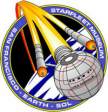 |
 |
Asia-Class Cruisers
![]() Diagrams
Diagrams![]()
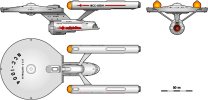 Orthographic views by Masao |
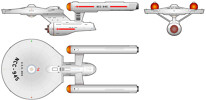 Revised version by Bernd |
 Deck plans, part 1 created by Allen Rolfes (see notes) |
 Deck plans, part 2 created by Allen Rolfes (see notes) |
![]() History
History![]()
At the end of the 22nd century, rapid progress in advanced propulsion, communications, and weapon technologies would soon allow their introduction in production warships. However, Starfleet was still reluctant to allow these new starship technologies to be tested under actual operating conditions. Because of several disastrous experiences, Starfleet Command considered equipping front-line ships with experimental technology to be both risky and a waste of resources. Moreover, new technologies were often incompatible with a ship's existing systems, necessitating a costly and time-consuming systems overhaul to return the ship to full operational status. Therefore, many developers of new technologies were forced to purchase or lease decommissioned ships as testbeds. The results gathered with these ships were valuable in that they could determine whether a single system performed properly within specified parameters, but they could not anticipate how the system would perform in a next-generation starship.
Starfleet's apparent lack of interest in emerging technologies also dissatisfied the Starfleet Corps of Engineering. In 2190, the Corps of Engineering submitted a proposal to Starfleet Command for the construction of a completely new prototype ship, highly modular and incorporating all the latest technologies in a single hull. The ship they proposed had twice the volume of the MOSKVA class and would have been Starfleet's largest cruiser type to date. However, the newly established Ship Development Council of Starfleet Command was sharply divided on whether to proceed with the proposed ship. One faction supported the building of the new prototype ship, whereas the other faction proposed that three units of the MOSKVA class instead be substantially upgraded, at a fraction of the cost of building an entirely new class. In 2192, the supporters of the new class prevailed when the their chief opponent, conservative Fleet Admiral Jean-Jacques Boucher, retired at age 94 and was replaced by a more progressive council member, Commodore Barbara Rashid.
The decision to commence development of the new class coincided with a request by the Federation Science Council for a larger, faster ship for long-term exploration. The Science Council argued that because Federation territory had expanded so rapidly, many outposts and colonies in the outer territories had not been visited by science vessels since initial survey missions decades before. On the other hand, the Science Council was not willing to maintain a fleet of large armed vessels, which would naturally be under the control of Starfleet. In 2191 the Federation Council decided to provide the Science Council with part of the necessary funding but also chose to place science missions at or beyond Federation boundaries under the command of Starfleet. This decision was instrumental in the foundation of the modern Starfleet with both military and scientific roles.
Seventy percent of the development costs for the new ASIA class were to be provided by Starfleet and 30% by the Science Council. Five ships, named for the five classical continents on Earth, were to be completed by 2195, but construction of only the lead ship, USS ASIA (NCC-945), was initially approved. The reason for this limited approval was that the cost of the new ships was expected to be many times higher than that of normal cruisers owing to the use of experimental or custom-designed technology instead of standard components. The construction of additional ships was nearly cancelled; however, in 2197 construction of USS AMERICA (NCC-991) and of the three remaining "continent" ships was approved. To complete the prototype ship, contracts were signed with an usually large number of constructors, many of which were actually consortia of companies, the most important being Yoyodyne for propulsion and power-generation systems. Final assembly of the ships was to take place at the San Francisco Fleet Yards.
Surprisingly, the development of the new LANCASTER class was barely affected by the decision to build the costly ASIA class. The two classes were developed almost completely independently of each other. Although the resulting hull shapes, owing to recent advances in subspace field dynamics, were similar, the two designs had few other features in common. Considering ASIA's limited, albeit modern, armament, it is not surprising that the military branch of Starfleet was always skeptical whether she would be a capable warship. Accordingly, Starfleet Command looked upon ASIA as primarily a testbed while the rather more conventional LANCASTER class would be equipped with new features in an incremental manner. The most obvious difference was that the lead ship, USS ASIA, cost more than twice as much as USS LANCASTER. The introduction of USS ASIA and USS LANCASTER established separate paths of scientific and military ship design, which were only reunited in the CONSTITUTION class of 2245.
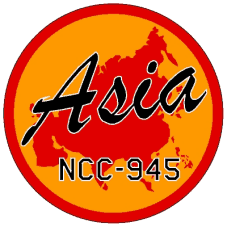 |
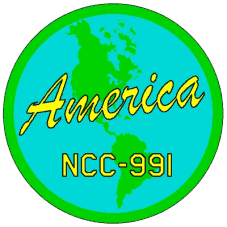 |
USS ASIA was launched from the San Francisco Fleet Yards on April 23, 2204, in a ceremony attended by many high-ranking members of the Federation Council. Shortly after the ceremony a severe maladjustment developed in the antimatter containment field of Yoyodyne's newly developed matter/antimatter reactor which prevented the warp core from being safely activated for a full year. After the containment field was successfully readjusted, the new warp core performed extremely well. In fact, similar reactor designs with dedicated long channels for matter and antimatter are still omnipresent in the 24th century. The next ship, USS AMERICA, followed in 2206, and the three other "continental" ships were commissioned in the following year.
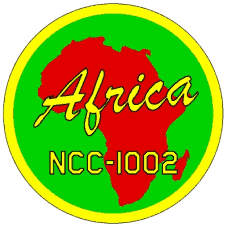 |
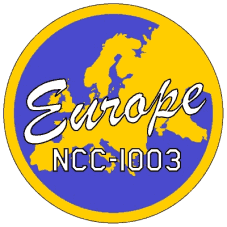 |
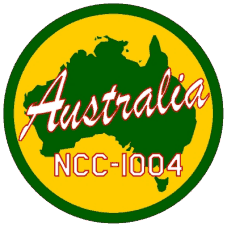 |
Although ASIA-class ships carried the most advanced technology of their time, their offensive capabilities could be considered adequate at best. On either side of the saucer were two type 5 phaser arrays, which could be easily swapped out. Unlike other contemporary phaser prototypes, the type 5 phasers already employed surface facets for beam emission rather than rotating turrets. The absence of mechanical components was intended to increase targeting speed and durability, but performance was poorer than expected, and after 2 years the type 5 phasers were replaced with the standard phaser emitter used for the LANCASTER class. The missile launch bays were able to hold as many as four of the latest fusion-tipped missile types. Additionally, a newly developed matter/antimatter weapon, informally dubbed "Thor's Lightning," entered service on USS ASIA in 2206 and on the four other ships in 2208. This self-propelled device was essentially a conventional missile whose fusion warhead had been replaced with an arrangement of matter and antimatter pods. When this missile was first introduced the risk the that antimatter containment of a single pod would fail was still rather high, and the cumulative risk on a ship carrying up to 20 missiles, each with 4 independent pods, was considerable. However, subsequent advances in antimatter containment essentially eliminated the risk of failure, and with the introduction of new acceleration tubes the weapon became the familiar photon torpedo.
The ASIA class was the first to be fully equipped with subspace radio and celerotronic computer technology that would become standard for the next 50 years. In addition, the ASIA class introduced significant advances in computer, life support, and power systems. Despite these innovations, a small group of military strategists still regarded these systems as being less important than weapons performance and speed as long as they performed well. However, the clearly improved systems of the ASIA class were quickly adopted for military ships as well.
When it became clear in the 2210's that the ASIA class was much better suited for exploration missions than were the comparatively inexpensive LANCASTER class then being built in much larger numbers, Starfleet ordered four more ASIA-class ships. ASIAs operated mostly on either side of the Federation border in the Alpha Quadrant, where they were less likely to encounter hostile ships than in the Beta Quadrant. Only one ship of the ASIA class, USS AMERICA, ever suffered heavy battle damage. In 2219, she was ambushed by two Klingon D-3 cruisers and subsequently retired from service.
Four starships of the ASIA class were nearly completely reconstructed from 2262 to 2265. Only the internal arrangement of the secondary hull and the core of the primary hull remained substantially unchanged. A novel, more-efficient warp drive was installed which allowed a maximum speed of warp 5.8. The ships were fitted with state-of-the-art phasers and photon torpedo tubes. The experiences with the reconstruction of the ASIA class proved useful when the refit program for the CONSTITUTION class started a few years later. Refitting was advantageous, since it was 50% less expensive than building a completely new starship. However, because even the reconstructed ships could not compete with newer designs, the last ASIA-class ship was decommissioned in 2287.
The last ship to enter service, USS THULE, was retired in 2255 and thus retained her original configuration. She served as an Academy training ship until 2298, but was considered beyond restoration and was scrapped. The only surviving ASIA-class ship, USS EUROPE (NCC-1003), is now on display at the Starfleet Museum.
![]() Commissioned Ships
Commissioned Ships![]()
| USS ASIA USS AMERICA USS AFRICA USS EUROPE USS AUSTRALIA USS JEFFERSON USS MANHATTAN USS YUKON USS THULE |
NCC-945 NCC-991 NCC-1002 NCC-1003 NCC-1004 NCC-1073 NCC-1074 NCC-1105 NCC-1106 |
![]() Specifications
Specifications![]()
Standard displacement: 157,800 mt
| Overall | 1° Hull | 2° Hull | Nacelles | |
| Length [m] | 225.10 | 100.79 | 81.49 | 117.95 |
| Beam [m] | 99.12 | 99.12 | 20.33 | 12.87 |
| Draft [m] | 54.88 | 19.30 | 23.45 | 13.94 |
Complement: 280 (40
officers + 240 crew), up to 100 visiting scientists or 150 ground
troops
Weapons: 4 phaser arrays, 4 missile tubes with a
total of 32 fusion and matter/antimatter missiles
Embarked craft: 8 FA-77 transatmo
fighter-bombers, 3 SG-19 heavy shuttlecraft, 4 medium personnel
shuttlecraft
Velocity: Warp 4.2, standard; Warp 5.1, maximum
Credits: Original design and text by Bernd Schneider, refined by Masao Okazaki
![]()